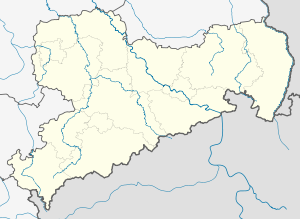Brams tunnel
|
Brams tunnel |
||
|---|---|---|
|
Course of the Bramsch Tunnel in Dresden-Löbtau
|
||
| Official name | Bramschstrasse tunnel | |
| use | Road tunnel | |
| traffic connection | Bramschstrasse ( Bundesstrasse 173 ) | |
| place | Dresden - Löbtau | |
| length | 660 (north tube), 667.5 (south tube) | |
| Number of tubes | 2 | |
| Largest coverage | 17 m | |
| construction | ||
| building-costs | approx. 104 million DM / 50 million EUR | |
| start of building | September 16, 1999 | |
| completion | 2002 | |
| business | ||
| release | November 30, 2002 | |
| location | ||
|
|
||
| Coordinates | ||
| East portal | 51 ° 2 ′ 58 " N , 13 ° 41 ′ 56" E | |
| West portal | 51 ° 2 ′ 51 ″ N , 13 ° 41 ′ 24 ″ E | |
The Bramsch (officially Bramschstraße tunnel ) is a road tunnel in the Dresden district Löbtau . It leads the federal highway 173 (Bramschstrasse) under a Wilhelminian style settlement and is part of the north bypass Dresden- Gorbitz , which should provide a better connection between the city center and the federal highway 17 .
Like Bramschstrasse, it is named after the Dresden entrepreneur Johann Ludwig Bramsch (1811–1877).
course
The Bramschtunnel begins shortly after the intersection Emerich-Ambros-Ufer / Fröbelstraße (east portal) and in its course crosses under Burgkstraße, Gohliser Straße, Rudolf-Renner-Straße, Klopstockstraße and Bramschstraße. Shortly before the confluence with Braunsdorfer Straße, the Bramschtunnel joins Coventrystraße in the Gorbitz district (west portal). In front of the east portal, connecting roads to the residential area branch off.
description
The core of the Bramschtunnel are two tunnels, each with a total driving width of 7.5 meters and two lanes . They lie 5–17 meters below the surface of the earth, the northern tube measures 660 meters, the south tube has a length of 667.5 meters. The tunnel walls are 40 centimeters thick and are made of concrete on which an insulating film has been applied. There are one meter wide walkways on both sides of the carriageway that can be used in an emergency.
The tunnel tubes are ventilated by eight steel fans . The lighting is carried out by sodium vapor lamps according to the counter- beam and mixed contrast lighting principle. For emergencies, there are a total of six emergency telephones and twelve fire extinguishers in the tunnel. The Bramschtunnel has an automatic fire alarm system and television monitoring at the two portals. There is a connecting tunnel between the two tubes, which is used as an escape route.
The control center of the tunnel is located between the two tubes at the west portal.
history
The preparatory work began on September 16, 1999 with clearing and demolition work at the tunnel entrances to the future west portal of the Brams tunnel. At the beginning of 2000, drilling began. The tunnel attack took place on March 22, 2000. The boreholes from 475 to 485 meters were carried out using the mining method, the remaining 185 meters using the open construction method. A total of around 100,000 cubic meters of earth was excavated. The tunnel breakthrough was reached on April 11, 2001, six months ahead of schedule.
The remaining work, such as sealing the tunnel vault and asphalting the roadways, followed by summer 2002 . With the access and connecting roads, the upgraded route has a length of around 1000 meters. The completed tunnel was opened to traffic on November 30, 2002. The construction cost around 104 million Deutschmarks or around 50 million euros . Three quarters of the costs were covered by subsidies, the remaining money (approx. 29 million marks) was contributed by the city of Dresden.
literature
- Bettina Klemm: Bramschtunnel should be ready by the end of November. In: Saxon newspaper . September 27, 2002, accessed March 30, 2013 (newspaper article).
- Bramschtunnel pushes under eight houses. In: dresden.de. State capital Dresden, May 22, 2000, accessed on December 17, 2016 (press release).
- Thilo Alexe: Two tubes lead right through Löbtau. Bramschtunnel in Dresden is almost finished. In: Saxon newspaper. September 27, 2002, accessed March 30, 2013 (newspaper article).
- Half a year in advance of the construction of the Bramsch Tunnel. In: dresden.de. State capital Dresden, April 9, 2001, accessed on August 15, 2015 (press release).



